The boom in English sparkling wines is proof that it’s perfectly possible to successfully grow grapes in the UK. Whether growing them outdoors, in the greenhouse or even in patio containers, there are plenty of varieties adapted to suit our colder climate. Not only do grape vines produce delicious fruit, but they also make attractive climbing plants for walls, arbours and trellis – their large, palmate leaves lend shade to sunny pergolas and provide attractive autumn colour.
Viticulture can be a complex subject, but lots of sun and regular pruning is the key to success. Here, our horticultural expert, Annelise Brilli shares step-by-step instructions for choosing, planting and caring for grape vine plants.
How to choose the best grape varieties – dessert or wine
If you want to grow grapes outside, wine varieties are the best option. Wine varieties fruit and ripen more reliably in cooler climates, although it’s essential to provide the maximum amount of sun for the longest period of time. A south or west-facing wall in a mild area of the UK is ideal.
Dessert grapes generally need the warmer temperatures of a greenhouse to ripen fully, although there are an increasing number of outdoor dessert varieties becoming available.
White grapes
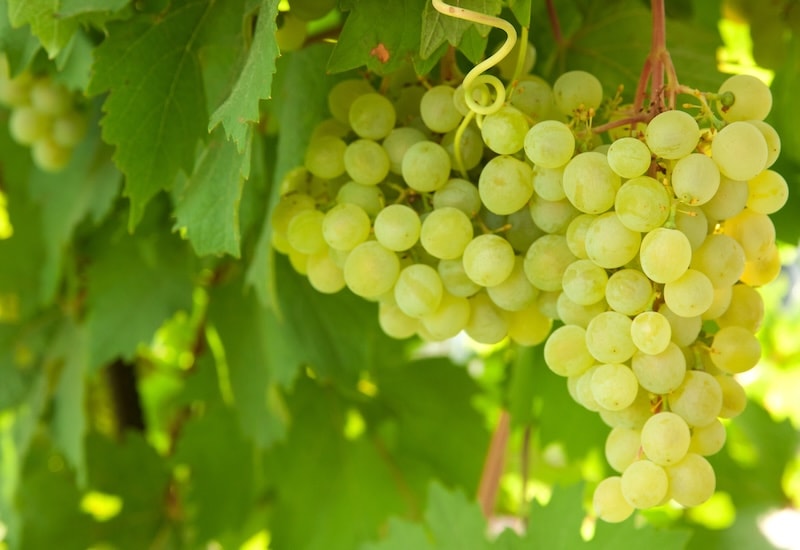
These white, seedless grapes grapes are sweet and delicious
Image: Grape ‘Lakemont’ from Suttons (dessert variety)
White varieties for wine-making are the easiest to grow outdoors. Grape ‘Bacchus’ is a reliable variety, recommended for outdoor growing with good crops of well-filled bunches that provide full bodied wines.
Although outdoor growing is best for mild, southerly areas, there are a few hardy varieties recommended for more northerly locations. Grape ‘Phoenix’ is renowned for its hardiness and high yields of very large white grapes in early October. Most wine varieties have tough skin and are unsuitable for eating, but a few such as Grape ‘Phoenix’ are dual purpose, provided you can give them enough sun and heat for the fruit to fully ripen to yellow.
For a fine flavoured dessert type, try Grape ‘Chasselas Doré’ – its golden fruits have a superbly sweet flavour and are delicious eaten straight off the vine. Seeded dessert varieties such as ‘Chasselas Doré’ are easier to grow, but Grape ‘Lakemont’ is a seedless variety recommended for UK climates except the far north.
Red grapes

This old variety reliably produces bumper harvests of sweet black grapes
Image: Grape ‘Boskoop Glory’ from Suttons (dessert variety)
Traditional red grape varieties are generally more suited to glasshouse growing, but there are varieties especially developed for outdoor growing in mild climates, including dessert types. Grape ‘Boskoop Glory’ is one of the best, producing heavy crops of large bunches of sweet grapes that are suited to both dessert and wine use.
Grape ‘Regent’ is a hardy, outdoor variety that not only yields large, dark red dessert grapes but also makes an excellent ornamental feature with its stunning red foliage in the autumn. Grape ‘Dornfelder’ also boasts good autumn colour, making a reliably hardy outdoor variety, ripening in early October with large bunches of blue-black dessert grapes.
Grapes for small spaces
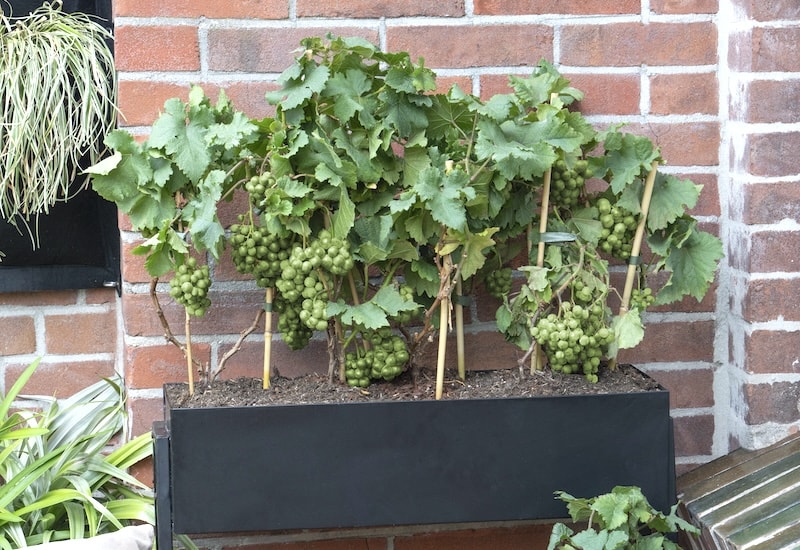
The world’s first compact wine grape can be grown in containers
Image: Grape Pixie™ ‘Riesling’ (wine variety) from Suttons
If you fancy growing some grapes but only have a small patio, balcony or terrace, ‘Pixie™ grapes’ are the answer. Specifically developed for small spaces, these compact grape vines will start to produce small grapes in their first year, continually flowering and bearing fruit through summer and into autumn. ‘Pixie™ grapes’ are perfect for growing in large containers in a sheltered spot outdoors, or in a small greenhouse.
When to plant grapevines
Vines can be planted anytime between October and March whilst they are dormant. Planting in autumn allows the vine to become well established by spring but carries the risk of frost damage. In colder areas it is best to wait until March. Bear in mind that grapevines are late to come into growth and may look dull and lifeless until May when they begin to shoot.
Where to plant grapevines
When planting outdoors, select the sunniest, warmest and most sheltered spot for your grapevine, preferably a south or west-facing wall. Avoid frost pockets as late frosts can damage the tender young shoots. Ensure that you give it plenty of space – grapevines are fast-growing and put on a surprising amount of growth during the season.
Grapevines require a fertile, well-drained soil with a pH of 6.5 to 6.8. Shallow chalk and heavy clays are not suitable. Prepare the ground well before planting, forking in compost and applying a general purpose fertiliser around the planting area.
How to plant grapevines outdoors
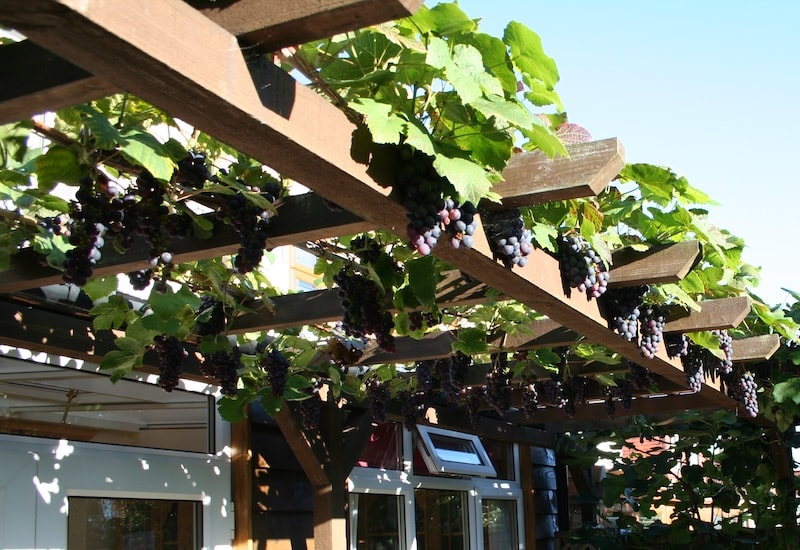
Grape wines make a beautiful feature when trained to climb
Image: Grape ‘Dornfelder’ from Suttons (wine variety)
Wherever you site your grapevine, you will need to put in a support system before planting, either fixing wires to the wall or fence, erecting a post and wire system, or providing a strong pergola to train your vine over.
The base of a wall or fence normally sits in a rain shadow and tends to be very dry. Therefore, position your grapevine at least a foot away, planting it at the same depth as it was in its pot – you should be able to see a dark mark against the stem indicating this. If planting more than one, space them around 1.2m (4ft) apart. After planting, place a thick mulch of compost around the base.
After planting, cut back the leading shoot to a strong bud, reducing it by about two-thirds so it reaches the first wire.
How to plant grapevines in containers
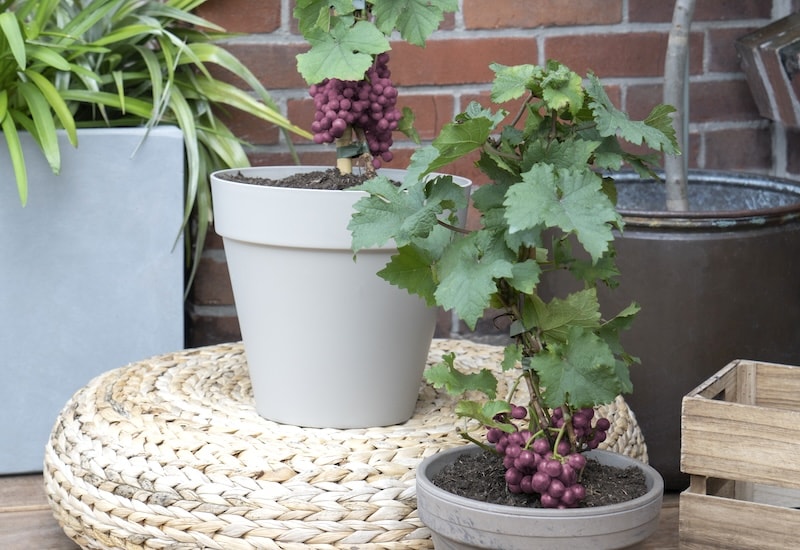
This dwarf wine variety allows you to establish a mini vineyard on your patio
Image: Grape Pixie™ ‘Cabernet Franc’ from Suttons (wine variety)
Grapevines can be grown in large containers, at least 60cm wide and deep, filled with a soil-based compost such as John Innes no.3.
Where space is at a premium, containerised grapevines can be trained as standards with a lollipop head. Alternatively select compact Pixie™ grapes, which have been selected for their short stems.
Greenhouse planting
Even smaller greenhouses can accommodate a grapevine, provided they are pruned correctly to encourage fruiting rather than excessive leafy growth.
Traditionally, grapevines are planted outside the greenhouse where their roots can naturally receive rainwater and nutrients. These traditional vineries have a hole at the base of the wall through which the main stem is fed and then trained along the inside of the house.
However, it is also possible to plant grapevines directly into a greenhouse border or large container, with the advantage that the soil will warm up quicker, promoting earlier growth. Position them at the far end of the house so they can be trained along the length of the wall.
Indoor grapevines planted in this way must be watered routinely without fail as they will not receive any natural rainwater.
How to care for grapevines

‘Regent’ is a popular, early-ripening variety often found in UK vineyards
Image: Grape ‘Regent’ from Suttons (wine variety)
Whether you grow your grapes in a sunny garden or undercover in a greenhouse, polytunnel or conservatory, here are a few tips to help care for them.
Watering
Grapevines are thirsty plants and attention must be paid to routine watering. Water grapevines thoroughly and regularly during the establishment phase, taking special care when dormant vines bud up in the spring and during dry periods. Even once established, outdoor vines benefit from routine watering, which encourages greater fruit set and bigger grapes.
Greenhouse vines and containerised vines will require even more frequent watering. Thoroughly soak greenhouse vines every week during the growing season. Container-grown vines may require daily watering from April to October. Watering should cease in early autumn to prevent fruit splitting.
Mulching
In late winter or early spring apply a thick mulch, at least 3in deep.
Feeding
Apply a high potash feed in February or March before growth starts.
Greenhouse and container-grown vines will require routine feeding throughout the growing season up until the grapes start to ripen and colour, when feeding should stop. Begin in spring with a high potash feed every 3 weeks, increasing to every week once the vine is in full leaf.
Removing flowers and fruit thinning
To encourage good establishment and strong, healthy plants, vines should not be allowed to fully fruit until their third or fourth year. Remove all of the fruit clusters or just leave one or two.
Fruit thinning encourages even ripening, good air circulation and larger fruits. However, it’s a fussy job, so it is normally reserved for dessert varieties. Long-bladed vine scissors are used to remove one in every 3 grapes per bunch and any diseased or damaged fruits. Avoid picking the grapes off by hand as this will result in bruising.
How to care for greenhouse grapevines

This classic grape variety is best grown under cover in the UK
Image: Grape ‘Cabernet Sauvignon’ from Suttons (wine variety)
Many people choose to grow grapes in their greenhouse, polytunnel, orangery or conservatory. Here’s how to care for your vines undercover.
Ventilation
Greenhouse grapevines are susceptible to fungal diseases and so require plenty of ventilation. Good air circulation also improves pollination.
During winter, keep the greenhouse cool and ventilate as much as possible as cold is required to induce dormancy.
Bark cleaning
Grapevines under glass are prone to a variety of scale insects and mealybugs that hide beneath bark crevices. In mid-winter, remove loose bark from the pruned rod by scraping it with a knife.
Pollination
In May, look out for developing flower trusses. When these open, pollination can be encouraged by shaking the stems or stroking a hand or soft brush over the flowers. All grapevine varieties are self-fertile so pollen from the same vine is suitable.
How to harvest grapevines

This seedless variety is ideal for growing in a cold greenhouse
Image: Grape ‘Autumn Royal’ from Suttons
Grapes are ready to harvest from August to November and are classified as early, mid-season and late.
- Early varieties: Ripen in September and are good for colder locations.
- Mid-season varieties: Ripen in the first half of October.
- Late varieties: Ripen in the second half of October/mid-November. Late varieties are best for indoor growing and may require heat as temperatures drop in autumn.
Test the ripeness of your grapes before harvesting. Ripening is less important for wine varieties which will not have the same sugar levels as dessert types, but they should still be tender and juicy. Once dessert grapes have coloured up, taste one or two fruits at regular intervals to see if they are sweet enough.
When harvesting, do not pull trusses off the vine but cut the whole bunch with scissors with the stalk attached.
How to prune grapevines
Grapevines produce fruit on the current year’s growth arising from wood of the previous year. They are very vigorous and regular pruning is essential to restrict leafy growth and encourage fewer but larger bunches of grapes.
The most common method of pruning is rod and spur pruning. The rod usually consists of a single, vertical stem which forms the permanent framework. Every winter the fruited stems are cut back to this permanent rod.
When to prune grapevines
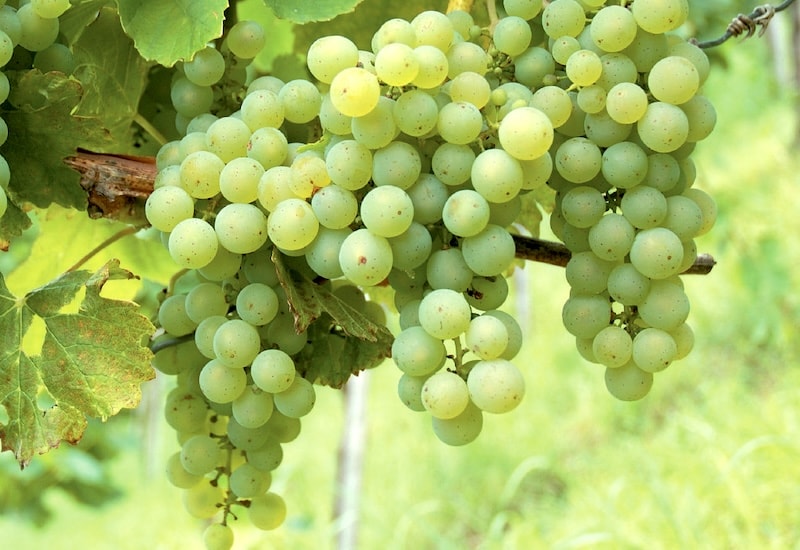
These grapes can be eaten straight from the vine or made into wine or juice
Image: Grape ‘Phoenix’ from Suttons
Pruning starts the first winter after planting. Grapevines should be pruned when dormant in late November/December and no later than midwinter to avoid the risk of heavy sap bleeding.
Further training and pruning are required in spring and summer when all excess shoots are continuously removed.
Rod and spur (cordon) pruning
Initial training years 1-3
The first three years of pruning concentrate on establishing a strong, permanent rod. All fruited side shoots are pruned back to this rod each year.
For the first three winters, prune the rod (the leading shoot) back by two-thirds. Prune all the side shoots (spurs) back by one or two buds. The second bud acts as an ‘insurance’ in case one of the buds fails.
In summer, tie in the new leading shoot or rod as it grows. As laterals begin to sprout from each spur, select only one for each. Each lateral that grows is then shortened to 5 or 6 leaves. All side shoots growing from the lateral are pinched back to one leaf.
Remove all developing fruit so the vine can concentrate on establishment.
Summer year 3 onwards
In future years, prune back each of the laterals that bear flowers to two leaves beyond the last flower cluster. Allow only one flower cluster for dessert grapes and one every 30cm for wine grapes.
Any laterals without flowers should be pruned back to 5 or 6 leaves. Throughout summer, pinch back any side shoots growing from the laterals to one leaf.
Winter year 3 onwards
Cut back the leader to a bud below the top wire. Prune back all the laterals to one or two buds.
Problems with grapevines
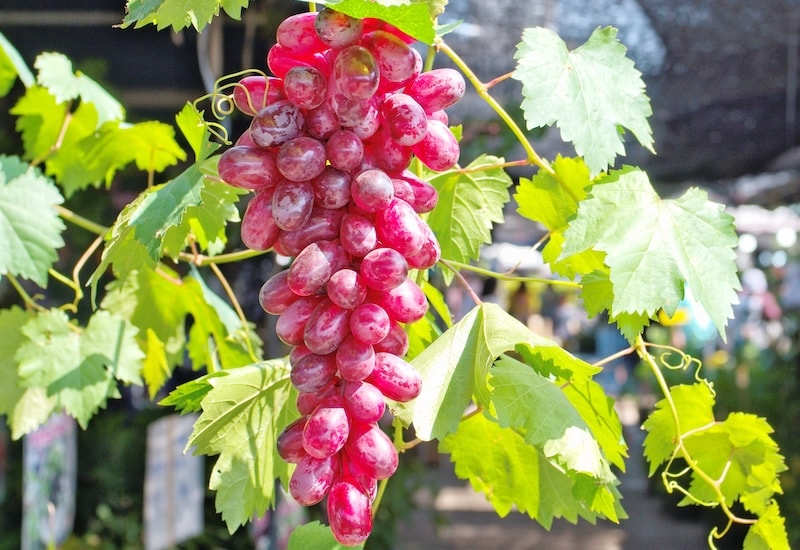
This grafted variety has improved disease resistance and produces sweet, crisp grapes
Image: Grape ‘Flame’ (Seedless) from Suttons (dessert variety)
Grapevines can suffer from fungal diseases such as downy mildew, powdery mildew, and grey mould. Vines that are stressed are more likely to succumb, so good cultural care is essential to keep your vine healthy and prevent infection. This includes:
- Good hygiene: Clean up all fallen leaves. Routinely clean greenhouses where vines are growing.
- Routine summer pruning: to promote good air circulation, ensure that you regularly remove any unwanted shoots throughout summer so vines do not become congested.
- Regular watering: Vines are very thirsty, especially those grown in greenhouses and containers. Give them plenty of water, directing it at the base of the vine rather than overhead.
- Mulching: Routine mulching will help to conserve water and reduce drought stress.
- Ventilation: Vines growing in greenhouses require plenty of ventilation.
- Treatment with surfactants: Treatments such as RHS Bug & Mildew Control contain a blend of surfactants and nutrients which work by physical action to control fungal diseases whilst boosting plant health to make them more resistant to pests and diseases.
Innovations in breeding and our warming climate have opened new possibilities for the enthusiastic home gardener who is keen on growing their own grapes. Whilst grapevine cultivation requires dedication, the results are extremely rewarding – grapevines are very long lived and will provide harvests of fresh grapes for decades.
We hope you have found our guide on how to grow grapevines useful. For more inspiration browse our full range of grapevines.
Image: Grape ‘Phoenix’ from Suttons
Last Updated on December 3, 2025 by Suttons Horticultural Team

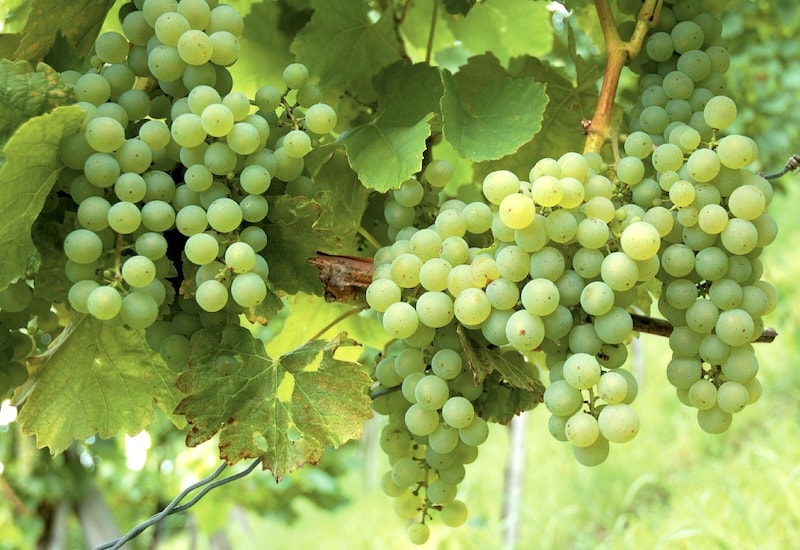




Hello David – have you followed through all the other steps in the last paragraph? – i.e good hygiene, routine summer pruning, regular watering, mulching and treatment with surfactants? Summer pruning is essential for good grapes – it is quite a lot of work as grapes grow fast and you have to thin out shoots and leaves continually to get good air flow and sun exposure – but it’s a key operation. Commercial grape growers use strong fungicides such as sulphur but these have a very negative environmental impact as well as ending up in the grapes you consume, so thorough implementation of the cultural controls listed above should be your priority.
My grape crop has been ruined two years running by mildew. The advice seems to be to have good air circulation, this vine is trained along a pergola and the bunches hang down with maximum air circulation but to no avail. What can I do??